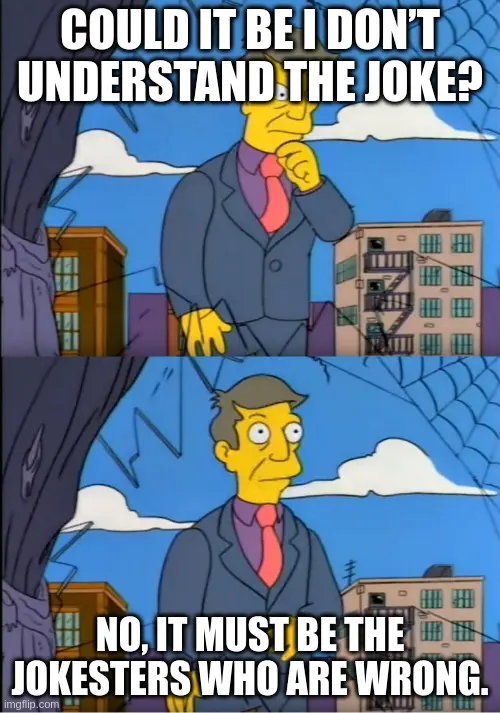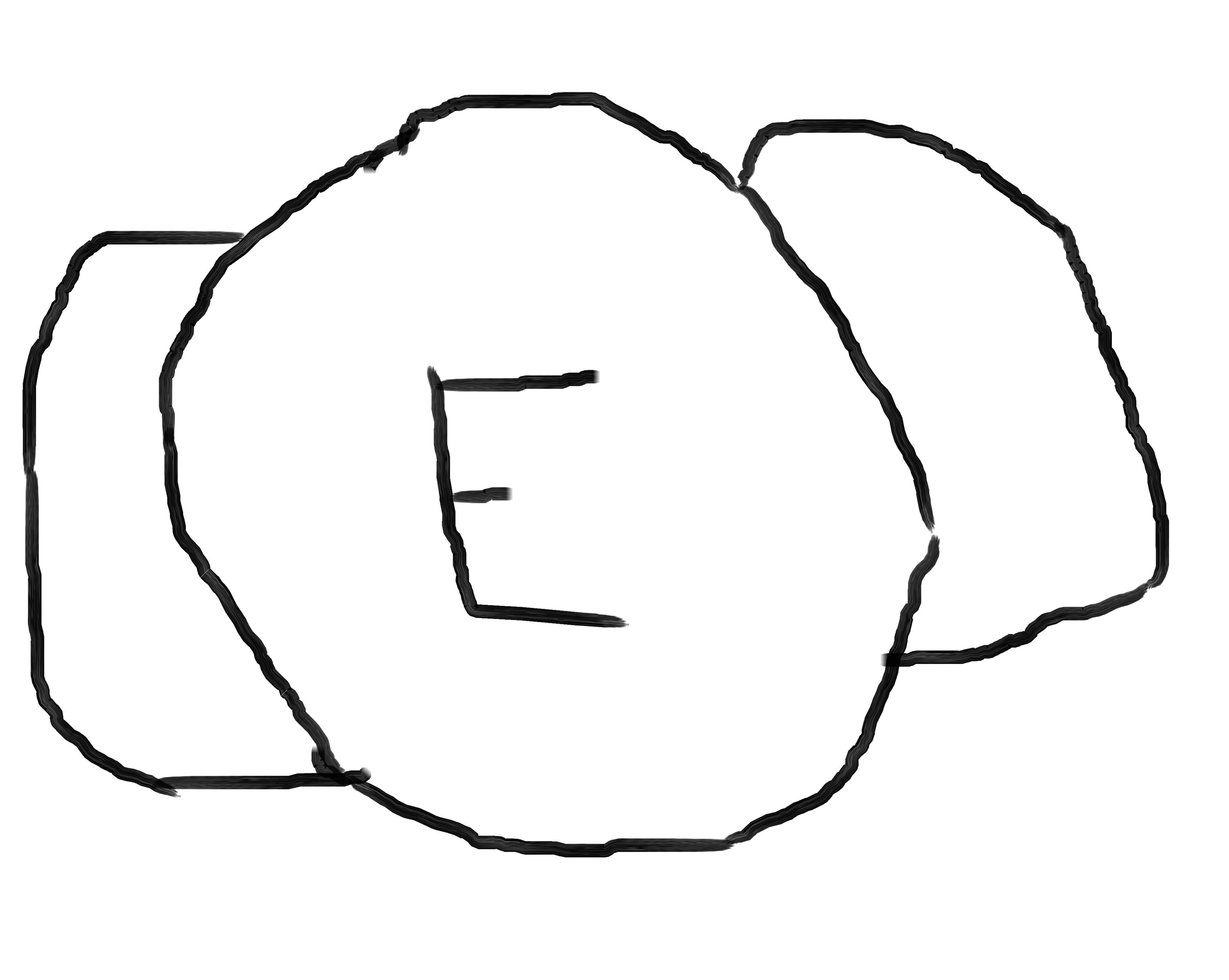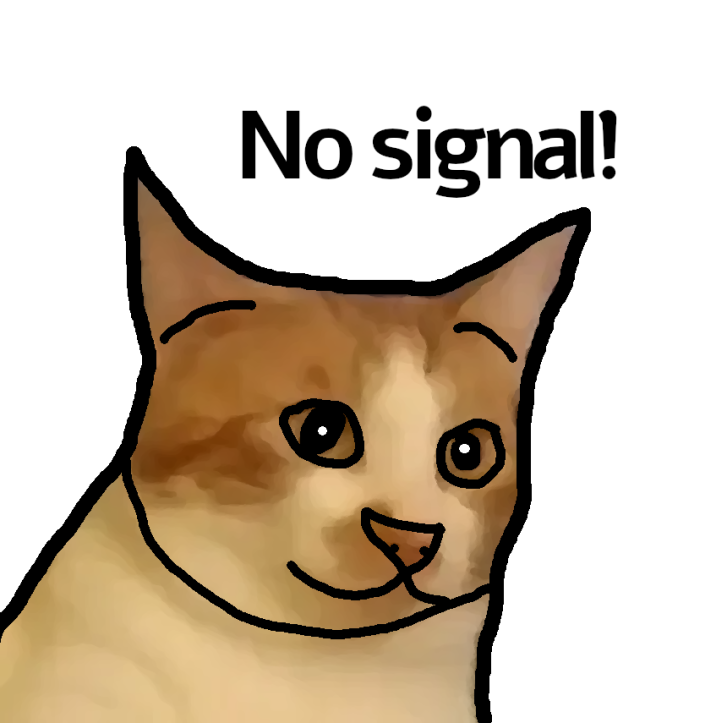- cross-posted to:
- [email protected]
- cross-posted to:
- [email protected]

I understand why this is wrong (order of operations dictates the division happens first, so it’s really 25 - 1 = 24), but why is it funny? I don’t mean “This isn’t funny,” I think I’m just missing the joke.
4! Is meant to be 4 factorial. 4! = 4 x 3 x 2 x 1 = 24
Aha! Got it, thank you so much.
And here I was thinking I was still decent at math. I got bamboozled…
Everybody forgets the factorial…
I always get a chuckle every time someone posted this in an unrelated comment.
Or if you don’t know order of operations, then you probably also don’t know factorials, so 20 / 5 = 4
Cause math people has a weird humor?

The exclamation point in the answer, from a math perspective, makes it 4 factorial: 4 x 3 x 2 x 1 = 24, which is the correct answer.
Best math meme so far.
This is quite possibly the best maths joke I’ve ever seen.
[edit] I guess it still can’t beat the ‘be rational’ / ‘get real’ one.
ASCII hack failure of language. Even in mathematics, ! has multiple meanings like with Boolean NOT. We need a science, math, and language reformation to remove non intuitive narcissistic names, and implied contextual meanings.
I’ve never seen ! used for boolean NOT in maths, just ¬. I think ! is something programming languages went for because it’s easier to type. That said, screw (a, b). Is that a (coordinate) pair, an interval, an inner product, some secret fourth thing? Who knows!
You might find Lojban interesting if you are not already aware. (I haven’t tried to learn it myself, I just know it exists)
Relevant xkcd
If someone wants to start a Lojban pun community, I would definitely subscribe just to learn about Lojban.
Although, if no one posted in the community, I wouldn’t be sure if it was a perfectly logical language or the community was just dead.
.i la lojban cu mutce lo ka smuske tinsa .i ku’i ly. na logji prane pe’i .i loi jbopre cu piso’iroi da’asnu lo ka prane nitcu .i ru’a lo klamburi cu na’e lojbo ka’u .i jy. xebni lo malgli .iseju lo nu lojbo klamburi zbasu cu nandu ba’a jeku’i cumki
Lojban is very semantically rigid, but not perfectly logical IMO. Lojbanists often argue about the necessity of logical perfection. I suspect that puns might not be seen as culturally Lojbanic. Lojbanists hate Anglicisms or bits of English leaking into the way they speak Lojban. Regardless, making Lojbanic puns might be difficult but it’s possible.
Jokes and tricks that hinge on unclear communication (eg: not using parenthesis or other notation to make intent clear), and then are smug when people are tricked, remind me of the old xkcd https://xkcd.com/169/
I just saw some jokes about factorials so at least I got this one, heh.
Sorry but what is unclear in OPs image?
25 - 5 ÷ 5when read naively left to right looks like it would be “25 - 5 = 20. Then take that and divide by 5, for an answer of 4”. It would be clearer to write it as(25 - 5) ÷ 5or25 - (5 ÷ 5)depending on what’s intended.You see those kind of “gotcha!” posts online sometimes, where someone posts a problem that tempts you into doing order of operations wrong.
Someone who sees how to do it correctly immediately and thinks everyone knows that is invited to view https://xkcd.com/2501/ as well.
Natively? It’s a math equation there is only one way to read it as far as I am aware.
Reread
Naively, not natively. Someone who wasn’t a good math student, or just doesn’t remember, might read it left to right and come to the wrong conclusion. The rules for order-of-operations are, so far as I know, arbitrary, and different people coming at it without instruction (ie: naively) could arrive at different conclusions. Knowing that you’re supposed to do division first isn’t obvious.
You could read
25 - 5 ÷ 5as “25 - 5 is 20. 20 divided by 5 is 4” or you could read it (correct, per the standard rules) as “25 minus… hold on… 5 divided by 5 is one. Now 25 subtract that from the 25 sitting over there, and get 24.” This isn’t the same kind of error as, like, “5 divided by 5 is 0”You could read
25 - 5 ÷ 5as "25 - 5 is 20.You could. You could also lower your pants and drop a massive turd and call that the answer. Both answers would be equally wrong.
PEMDAS isn’t a suggestion that you follow when it suits you, like religion. It’s how math is communicated, unambiguously.
In any case, if that’s where we lost you, then I’ve calculated the chance of you catching the factorial as √-1.
On the extremely rare occasion when I have the misfortune to be performing a mathematical calculation, I take enormous pleasure in carrying out the operations exclusively left to right unless indicated otherwise by brackets, which is the correct way to indicate this. If you want me to do a calculation separately, put brackets around it or bugger off. It’s your choice, really
unless indicated otherwise by brackets, which is the correct way to indicate this
No it isn’t. The order of operations rules are at least 200 years older than the use of Brackets in Maths. Not sure how you think Maths was done before we started using Brackets.
put brackets around it or bugger off.
Bugger off with your disinformation. There are no Maths textbooks which use Brackets for such a basic expression. Students are expected to know the order of operations rules
Many of the things we believe about ourselves and our experiences turn out to be false. Sometimes this is due to innocent memory failures or to the lack of needed information.
Suppose that Charles believes that he failed his biology test because the professor asked obscure and ambiguous questions.
Charles believes this because he doesn’t realize that he got the lowest score out of the 100 students who took the test, and that most people did quite well.
If Charles had this information, he would realize that he failed the test because he didn’t study hard enough, or because he’s not very good at biology.On the other hand, if Charles continues to believe that the test was unfair after seeing the grade distribution, he is either severely challenged in his capacity for rational calculation or he is the perpetrator of willful ignorance.
Which is it?
You’re being weirdly aggressive, but okay.
Most people know the symbols for addition subtraction multiplication and division. Far fewer people know the established order of operations. That’s what powers those “only 3% of people solve this problem correctly!” math memes.
But okay. Communicate badly (ie: by failing to acknowledge your audience’s context) and be smug if you want.
You do realize your “You’re communicating badly” attitude is the only smugness happening here, right?
Oh you’re gonna love my other reply then.
Don’t expect me to pander to willful ignorance. If you’re going to act like an idiot, expect to be treated like one.
Also, what’s with the passive aggressiveness? I understand that my confrontational approach there can make some people uncomfortable, but it’s my prerogative.
The rules for order-of-operations are, so far as I know, arbitrary
No, they’re not.
Knowing that you’re supposed to do division first isn’t obvious.
It is if you’ve been to school or read a Maths textbook
correct, per the standard rules
The only rules
People don’t read math like that tho, as you learn the order of operations in year 2. Also, the original post is correct,
25 - 5/5 = 4!
Comment section full of people looking for an opportunity to argue
No it isn’t
Did nobody learn order of operations?
The meme is correct. It is 4!.
Yeah but it’s playing on the idea that the reader would think 25-5÷5 is 4. That’s the joke. Without it there’s no punchline.
No no, they’re saying “4!” literally is the answer. The joke is that you say 4!, the other person who presumably knows the order of operations assumes you got it wrong and did 25 - 5 = 20 ÷ 5 = 4 when really you do division first so the real answer is 24. The punchline is that “4!” is how you write 4 factorial or 1 × 2 × 3 × 4 which is 24.
Yes, I understand that 4! is the correct answer. That is not my point. Without the misconception that the answer is 4, there is no punchline. This comic strongly implies that the natural assumption should be that the answer is 4, and that the secret, hidden answer is 24. In other words, in a world where people understand order of operations, the comic is not funny, because you wouldn’t look at that and think 4 is a reasonable answer.
The joke relies on, as you put it, the assumption you did it wrong.
No the joke is that first think they got wrong, then realize it’s a factorial so they got it right (the a-ha moment!).
Then we realize that they might not have gotten it because the wrong answer is 4 and they may not know of factorials.
The ambiguity is very clever. Some other commenters call it a pun.
that commenter was me. Try ctrl+f.
Your explanation of the joke would suggest that it would be equally funny if the question were “what’s 21 + 3?” But obviously that isn’t true – the joke is meant to be that both 4 and 4! are equally valid answers to the question. However, in reality, 4 is not a valid answer; I just feel the same disappointment any prescriptivist feels when they see a word misused.
No because 4 is the obvious wrong answer. 21+3 my isses idea completely.
4(exclamation) is wrong while 4(factorial) is right.
I think the smugness of someone who knows factorials is also part of what makes it fun.
5-5/5 != 4
Very funny joke, but I don’t agree with the division sign. Its supposed to be either a / or \ depending on which way you want to divide.
never in my life have I seen a
\division sign.Well it was a joke, but it seems like a lot of people did not get it.
I’m only going to say this once but if I’m doing a sum and you want me to do it in a specific order, use brackets. That’s what brackets are for. Don’t expect me to do things in a predetermined order because I literally can’t be bothered and I will never care enough to do that. I’m already doing a sum so don’t push it, okay bud
But that’s a bit like saying “If you’re going to talk to me, put the adjectives before the nouns,” even in Spanish where they come after. Mathematical notation is a language and it has a syntax. Sure, you can decide to ignore that syntax, or insist that people modify their use of it for you, but it’s not really a reasonable expectation.
I think this is very stupid for a number of reasons. Why is there an order of operations that supersedes the direction the operations are written in? That’s at best dim witted and at worst deliberately misleading. Grog write left to right. Grog read left to right. Grog do sum left to right.
There is absolutely no reason in the world why anybody should have to know that division comes before subtraction. That’s fucking insane, man. What is the point of writing things down if you’re only going to do them in a set order anyway? May as well have a big jumble of letters and numbers and symbols on the page at that point, like who cares. The whole point of writing things down is to express concepts. Can’t do that with any kind of nuance if you’re going to read it one way anyway, no matter how you write it down. That would be like saying you always pronounce certain letters at the start of words even if they’re in the middle. Completely nuts.
Grog write left to right.
Gorg is from another country and writes right to left.
Grog read left to right.
Gorg reads right to left
Grog do sum left to right
Gorg does sums right to left
If all people did was simple equations like the one in the OP, you’d probably be right, but math syntax has to deal with all kinds of equations. Your way, I can’t write 3x^2–4x+5. Instead, I’d have to write ((((3x)^2)−4)x)+5. That’s WAY more obnoxious. It’s better to have an unambiguous syntax that covers all the cases and lets me write equations in an more simple form.
well then you should stop doing math cuz you’re doing it wrong
Thanks I take enormous pleasure in never doing any maths at all ever, largely for reasons like this 😌
Imma be weird and argue that the answer actually should be 4.
Dear Aunt Sally is great or whatever, but syntax also fuckin matters. We can all probably agree that the faster, more intuitive answer is obviously 4. Most of those in the western world (meme’s largest audience) read left-to-right and there is nothing the delineate that division must actually come before inverse addition until one has carefully examined the entire the problem (which you should definitely be doing, dumb-dumb) and slapped on another layer of thinking (inefficient waste of time when doing quick mafs). Use the damn parenthesis, ffs!
Using parentheses where a few simple rules will do seems awfully inefficient. Both to write and to read.
Textbook authors be like:
sintx^2 + cosπx^3 - 3
Simple rules are only simple if they are intuitive and consistently applicable. Otherwise, they are nothing more than yet another thing to remember and think about, yet another source of error, and yet another possible point of confusion. With enough time/ effort, one can brute force the intuitiveness, but that doesn’t automatically make the rule good or universally useful.
As a math teacher, I can assure you that not everyone has the same level of understanding or knowledge when it comes to order of operations. Some people struggle to remember the specific order, and mnemonics are worthless. Others struggle to read or visually process problems written with unclear or inconsistent symbology. Hell, most people don’t even learn exactly the same fucking rules. Tell me, where is the simplicity in all of that?
When I teach order of operations, the glass eyes and exasperated sighs of frustration come out. But when I teach just the parenthesis and exponent stuff, lightbulbs and understanding. Suddenly, people “too dumb” to do 2+2 are doing algebra and getting excited about math for the first time ever. Some of this is certainly a failing of our collective education system, but we can’t just forget that everyone has their own flavor of learning disability, neuro-diversity, and life experience. Simple rules quickly fail to be simple in the face of complex people.
Hell, most people don’t even learn exactly the same fucking rules.
Yes they do, but sure, go ahead and produce a Maths textbook which teaches different rules to all the others (I’ve never seen one yet) - I’ll wait 😂
Following your logic,
2*7²+5*3³ becomes (2(7²))+(5(3³))
Talk about inefficient waste of time.
I find this to be unironically both easier to read (by an incredibly wide, dyslexic margin) and faster to write and type.
Parenthesis consists of only two symbols that only require two keyboard keys and a single stroke of a pen to write compared to the four keys and varying strokes of the standard operators (aka. more efficient). But, far more importantly for me anyway, “+”, “×”, “*”, “÷”, all look nearly identical unless I stare the keyboard or problem for an agonizing century (waste of time, perhaps?) and even then it’s a mystery whether my brain processed the symbology correctly or put the numbers in the right spot to do math (yep, waste of time). The humble ( ), however, is very easy to see, and it creates neat little windows that don’t leave much room for misinterpretation.
2*7²+5*3³ = accessibility nightmare
(2(7²))+(5(3³)) = readable with clearly defined order of operations
I did preface this by pointing out I’m weird.
Oh, you’re trolling. Carry on, then.
Oh, you don’t know how to read, carry on then.
lol are legitimately saying this was not a joke?
Parenthesis consists of only two symbols that only require two keyboard keys and a single stroke of a pen to write compared to the four keys and varying strokes of the standard operators
The humble ( ), however, is very easy to see, and it creates neat little windows that don’t leave much room for misinterpretation.
2*7²+5*3³ = accessibility nightmare
(2(7²))+(5(3³)) = readable with clearly defined order of operations
I mean, I guess I have no reason to doubt your word so I’ll just believe you were being serious and respond in kind.
Time savings you might gain from parentheses being easier to write and requiring less keystrokes is lost on you needing to use twice as many since they come in pairs.
Furthermore, with the exception of *, which we don’t even write most of the time, you still need to use all of the other operators even with parentheses, so using them everywhere isn’t even a trade off, it’s a net loss. This also means that parentheses will not help you differentiate between the operators because you’ll still be using them.
Finally, the only reason you find the example I gave easier to read with parentheses is because I used a lot of multiplication, but you have multiplication to thank for that, not parentheses. In most cases, it would have fairly simple expressions like this:
1+2+3+4+5+6+7+8
turned into this:
1+(2+(3+(4+(5+(6+(7+(8))))))
If you truly want to eliminate ambiguity, have a look at reverse polish notation. I find it confusing as hell but some people like it.
Ok, now I’m curious, why is it only after I call you out that you decide to read what I wrote with any criticality? What about my argument (which I happily acknowledged was based purly on personal experience, and therefore not all parts are universally applicable to everyone) makes you think I’m nothing more than a dumb internet troll with no meaningful opinions or thoughts worth sharing or discussing like adults?
Sure, parenthesis need a buddy, but I still find them a lot faster to type simply because it is always the exact same two keys. No stopping to hunt for operators and symbols that seem to move or disappear every, single, fucking, time. When handwriting, parenthesis only takes one single, quick stroke that stays in line with what you are writing (maybe a small thing, but I find it important if my hands hurt, aka. always).
At no point have I argued the elimination of the operators, only that using them exclusively determine order of operations presents an accessibility issue and is largely unintuitive for many individuals.
The actual reason I find the parenthesis easier to read is because it isolates the problem into distinct, physically easier to read sections that eliminates a hard to distinguish operator and creates a clear step-by-step process to solving the problem that doesn’t really on any rule beyond working from the inside out.
Single operator problems can be solved in any sequence, no parenthesis or order of operations needed. In your example, it’s literally no different than combining like terms. But beyond basic cases like that, parenthesis always create a more comprehensible problem. Tell me, which is more clear and has less room for error:
1+2+3×4+5+6
1+2+3÷4+5+6
1+2×3÷4*5-6
OR
(1+2+3)(4+5+6)
(1+2+3)/(4+5+6)
1+((2×3)/(4×5))-6
Literally, all I’m arguing is that parenthesis make math easier to read and less prone to error or unintentional misinterpretation and should therefore replace the potential amigousness of order of operations. On top of that, I find them to be dramatically more efficient. Not everyone feels the same, fair enough, not really trying to paint with broad strokes on that front.
makes you think I’m nothing more than a dumb internet troll with no meaningful opinions or thoughts worth sharing or discussing like adults
Holy fuck. I called you one out of all of those and it was the one who isn’t even a pejorative. I thought you were joking, because your comment sounded like you were joking. There’s really no deeper meaning to that.
No stopping to hunt for operators and symbols
That’s what I’m saying, using parentheses won’t make the operators and symbols go away. You’ll still have to stop and hunt for them, you’re just adding parentheses in addition to that.
because it isolates the problem into distinct, physically easier to read sections
That’s only true for simple expressions, though. Once you try to type something more complicated, parentheses get very confusing very fast. Anyone who’s ever had WolframAlpha refuse to evaluate an expression because of a missing parentheses knows what I mean.
As for your examples,
1+2+3×4+5+6
1+2+3÷4+5+6
In these, the version with parentheses is different from the one without because you want the operations to be done in a certain order that isn’t indicated anywhere.
1+2×3÷4*5-6
And in this one, you’re mixing several operators with equal priority on the same line while not indicating which one you want to be done first.
What I’m getting at is that you’ve provided the exact examples where you have to use parentheses so it makes no sense to ask which one is clearer because only one version is correctly written. It would be like me asking you if (24)+1 is clearer than 2*4+1 and concluding parentheses are confusing because you didn’t divine I wasn’t typing twenty four but instead wanted you to multiply the 2 and 4.
Finally, the order of operations isn’t just some arbitrary convention, it might seem that way when we limit ourselves to only numbers but its intuitiveness really shows in algebra. Take the polynomial:
2x²+1
Even if you’ve never heard of the order of operations, there’s absolutely zero confusion about which order you’re meant to do the operations. It would take a madman to decide that “+1” is part of the exponent or that you’re supposed to add the 1 to the x² and then multiply it by 2.
In this case, adding parentheses here would turn it into
2(x(²))+1
which is unnecessary and it gets annoying very fast. For example:
(2(x))+(3(x(²)))+(5(x(³)))+(8(x(⁴)))
vs
2x+3x²+5x³+8x⁴
You might say that’s not fair because this expression clearly needs no parentheses so I just added them to make it seem more confusing and you’d be right but that’s the point: there has to be an arbitrary line where we decide parentheses are no longer necessary and that’s the order of operations. We settled on that because that’s what works in algebra. When it comes to what’s intuitive in arithmetic, left to right is obviously the best (for westerners). Unfortunately for arithmetic, we’ve decided that intuitiveness in algebra is more important than intuitiveness in arithmetic.


















